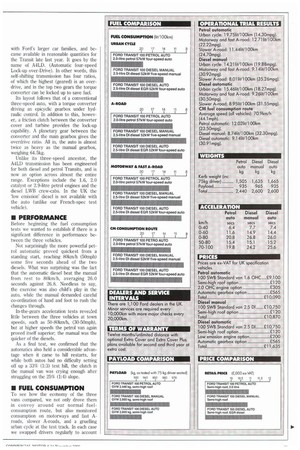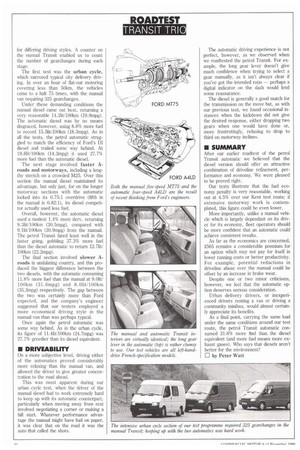• Stuck in a jam again? Whether in a city
Page 29

Page 30

Page 31

Page 32

If you've noticed an error in this article please click here to report it so we can fix it.
centre or on the centre lane of a motorway, the picture is becoming iilarmingly common. Traffic. All around you, bumperto-bumper, nose-to-tail, kerb-to-kerb.
The unfortunate driver is left to pump the clutch and shove the gear lever about like there's no tomorrow. Even with the lightest controls this is tiring enough: where more substantial effort is required, you need the strength of Maradona's left thigh and Henry Cooper's left hook.
It's at moments like this that automatic gearboxes begin to look rather attractive, and although most HGV drivers will have a long time to wait before self-shifting transmissions become commonplace, some light CV manufacturers are able to supply them now.
Which is all very well; but don't automatics use a lot more fuel than their manual equivalents?
Ford, for one, says not. We tested its Latest four-speed auto in a petrol Transit at the start of the year (CM 11-17 January). Ford suggests that when the auto is teamed up with the popular 2.5-litre DI diesel consumption figures are very close to, and in some cases better than, the five-speed manual alternative.
With the help of Ford's European division we have been able to put these claims to the test by running three otherwise identical Transits in convoy over a variety of operating conditions.
• TEST VEHICLES
Our three test vehicles are shortwheelbase Transit 100s with the semihigh-roof option: two diesels and one petrol-driven.
One of the diesels has the usual 52kW (7011p) 2.5-litre engine and standard fivespeed manual box; the other is fitted with the automatic transmission and the latest `low emission' diesel.
The `low emission' diesel, incidentally, is now a £200 option in the UK, and uses exhaust gas recirculation (EGR) to cut
harmful emis§ions, notably the nitrogen oxides (N05). Neither performance nor economy is affected, so our two diesel vans are still directly comparable.
'rhe third of our three Transits is a petrol-engined automatic employing the long-lived 57kW (77hp) 2.0-litre unit. It serves as a useful benchmark against which to compare the consumption and speed of the two diesels.
All three vehicles use the standard 4.56:1 final-drive ratio, and all tests were conducted laden to the relevant gross weight. This gave each van a nominal onetonne payload, including passengers, with
the diesels running at 2.60 tonnes gross and the petrol at 2.44 tonnes (the diesels have a greater plated weight to accommodate the heavier engine).
Readers will see from the pictures that the Transits are to French left-hand-drive specification. Aside from some minor trim variations, however, this is essentially the same as the UK spec so the results are unaffected.
• TRANSMISSIONS
Both of the gearboxes involved in this test are recent designs which represent Ford's latest thinking about what manual and automatic transmissions should be like.
The manual MT75 unit, which was launched early last year, is shared with the Sierra and Granada saloons. Claimed to be lighter, stronger, more compact and more efficient than the transmissions it superseded, its, main technical features include a die-cast aluminium casing, needle-roller bearings to support the gears, two-part gear construction and synchronisation on reverse gear.
The five-speed transmission weighs in at 35kg and has a direct-drive fourth with overdrive top.
The automatic gearbox is also shared
with Ford's larger car families, and became available in reasonable quantities for the Transit late last year. It goes by the name of A4LD. (Automatic four-speed Lock-up over-Drive). In other words, this self-shifting transmission has four ratios, of which the highest (geared) is an overdrive, and in the top two gears the torque converter can be locked up to save fuel.
Its layout follows that of a conventional three-speed auto, with a torque converter driving an epicyclic gearbox under hydraulic control. In addition to this, however, a friction clutch between the converter cover and turbine provides the lock-up capability. A planetary gear between the converter and the main gearbox gives the overdrive ratio. All in, the auto is almost twice as heavy as the manual gearbox, weighing 64.5kg.
Unlike its three-speed ancestor, the A4LD transmission has been engineered for both diesel and petrol Transits, and is now an option across almost the entire range. Exceptions include the 1.6, 2.0 catalyst or 2_9-litre petrol engines and the diesel LWB crew-cabs. In the UK the 'low emission' diesel is not available with the auto (unlike our French-spec test vehicle).
• PERFORMANCE
Before beginning the fuel consumption tests we wanted to establish if there is a significant difference in performance between the three vehicles.
Not surprisingly the more powerful petrol automatic proved quickest from a standing start, reaching 80km/h (50mph) some five seconds ahead of the two diesels. What was surprising was the fact that the automatic diesel beat the manual from rest to 80kmih, averaging 26.0 seconds against 26.8. Needless to say, the exercise was also child's play in the auto, while the manual demanded careful co-ordination of hand and foot to rush the changes through.
In-the-gears acceleration tests revealed little between the three vehicles at town speeds, such as 50-80krnib, (30-50mph), but at higher speeds the petrol van again proved itself superior; the manual was the quicker of the diesels.
As a final test, we confirmed that the automatics also held a considerable advantage when it came to hill restarts, for while both autos had no difficulty setting off up a 33% (1:3) test hill, the clutch in the manual van was crying enough after struggling on the 25% (1:4) slope.
• FUEL CONSUMPTION
To see how the economy of the three vans compared, we not only drove them in convoy around our normal fuelconsumption route, but also monitored consumption on motorways and fast Aroads, slower A-roads, and a gruelling urban cycle at the test track. In each case we swapped drivers regularly to account for differing driving styles. A counter on the manual Transit enabled us to count the number of gearchanges during each stage.
The first test was the urban cycle, which mirrored typical city delivery driving. In over an hour of flat-out motoring covering less than 50km, the vehicles came to a halt 75 times, with the manual van requiring 325 gearchanges.
Under these demanding conditions the manual diesel came out best, returning a very reasonable 14.2lit/1001un (19.9mpg). The automatic diesel was by no means disgraced, however, using 8.8% more fuel to record 15.51it/100km (18.3mpg). As in all the tests, the petrol automatic struggled to match the efficiency of Ford's DI diesel and trailed some way behind. At 19.81it/100km (14.3mpg) it used 27.7% more fuel than the automatic diesel.
The next stage involved faster Aroads and motorways, including a lengthy stretch on a crowded M25. Over this section the manual diesel maintained its advantage, but only just, for on the longer motorway sections with the automatic locked into its 0.75:1 overdrive (fifth in the manual is 0.82:1), its diesel competitor actually used less fuel Overall, however, the automatic diesel used a modest 1.4% more derv, returning 9.31it/100km (30.5mpg), compared with 9.11it/100km (30.9mpg) from the manual. The petrol Transit fared least well in the faster going, gobbling 37.3% more fuel than the diesel automatic to return 12.7liti 100km (22.2mpg).
The final section involved slower Aroads in undulating country, and this produced the biggest difference between the two diesels, with the automatic consuming 11.8% more fuel than the manual at 9.01it/ 100km (31.6mpg) and 8.01it/100km (35.3mpg) respectively. The gap between the two was certainly more than Ford expected, and the company's engineer suggested that our testers employed a more economical driving style in the manual van than was perhaps typical.
Once again the petrol automatic was some way behind. As in the urban cycle, its figure of 11.41it/100km (24.7mpg) was 27.7% greedier than its diesel equivalent.
• DRIVEABILITY
On a more subjective level, driving either of the automatics proved considerably more relaxing than the manual van, and allowed the driver to give greater concentration to the road ahead.
This was most apparent during our urban cycle test, when the driver of the manual diesel had to work extremely hard to keep up with its automatic counterpart, particularly when moving away from rest involved negotiating a corner or making a hill start. Whatever performance advantage the manual might have had on paper, it was clear that on the road it was the auto that called the shots.
The manual and automatic Transit interiors are virtually identical; the long gear lever in the automatic (top) is rather clumsy to use. Our test vehicles are all left-handdrive French-specification models.
The automatic driving experience is not perfect, however, as we observed when we roadtested the petrol Transit. For example, the long gear lever doesn't give much confidence when trying to select a gear manually, as it isn't always clear if you've got the intended ratio — perhaps a digital indicator on the dash would lend some reassurance.
The diesel is generally a good match for the transmission on the move but, as with our previous test, we found occasional instances when the kickdown did not give the desired response, either dropping two gears when one would have done or, more frustratingly, refusing to drop to third on motorway inclines.
• SUMMARY
After our earlier roadtest of the petrol Transit automatic we believed that the diesel version should offer an attractive combination of driveline refinement, performance and economy. We were pleased to be proved right.
Our tests illustrate that the fuel economy penalty is very reasonable, working out at 4.5% over our Kent test route; if extensive motorway work is contemplated, this figure could be even lower.
More importantly, unlike a manual vehicle which is largely dependant on its driver for its economy, fleet operators should be more confident that an automatic could achieve consistent results.
As far as the economics are concerned, 565 remains a considerable premium form option which may not pay for itself in lower running costs or better productivity. For example, potential reductions in driveline abuse over the manual could be offset by an increase in brake wear.
Despite one or two minor criticisms, however, we feel that the automatic option deserves serious consideration.
Urban delivery drivers, or inexperienced drivers renting a van or driving a community minibus, would almost certainly appreciate its benefits.
As a final point, carrying the same load under the same conditions around our test route, the petrol Transit automatic consumed 31.6% more fuel than the diesel equivalent (and more fuel means more exhaust gases). Who says that diesels aren't better for the environment?
LII by Peter Watt




















































































